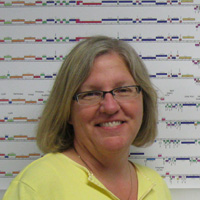Welcome to the forums at seaphages.org. Please feel free to ask any questions related to the SEA-PHAGES program. Any logged-in user may post new topics and reply to existing topics. If you'd like to see a new forum created, please contact us using our form or email us at info@seaphages.org.
Recent Activity
All posts created by debbie
| Link to this post | posted 15 Mar, 2019 01:12 | |
|---|---|
|
|
Evan, Keep in mind that the coding potential is based on a sample of the sequence from each genome, so why would you expect them to be the same? The use of comparative genomics is helpful and necessary here. to prove the point, I just ran GeneMark on Stanktossa and got a different result than you did. Yes, coding potential is very important, but this shows you that it has to be thought of in context. The comparative genomics are impressive. |
| Link to this post | posted 14 Mar, 2019 14:36 | |
|---|---|
|
|
Evan, Have you read this? https://seaphagesbioinformatics.helpdocsonline.com/article-4 Both Glimmer and GeneMark use a sample of the target genome, so if you run them 10 times you MAY get some differences. Those differences occur most commonly when predicting 'small' genes. It is the primary reason we hand curate the genomes. As for your question, please provide specifics: what gene, what genome, and any other pertinent data. Thanks, debbie |
| Link to this post | posted 14 Mar, 2019 01:39 | |
|---|---|
|
|
Hari, Basically yes. However, when you add gene "11" in HarperAnne, add the gene only in that frame. If you add a gene that starts at 10 and ends at 11 it will be difficult to see where to slip it. (But if you know that coordinates of the slippage, it won't matter.) Then go back and chagen the start and add regions when you have it figured out. debbie |
Posted in: Annotation → Annotations of Microbacterium foliorum
| Link to this post | posted 12 Mar, 2019 17:07 | |
|---|---|
|
|
Claire, It works! Thanks, debbie |
Posted in: PECAAN → New Features in PECAAN
| Link to this post | posted 05 Mar, 2019 19:06 | |
|---|---|
|
|
Steve, Most minor tail proteins are called by synteny. Sometimes there is no HHPred info to support the call. It is common to call the 4-5 genes "big" downstream of the tape measure "minor tail proteins". In addition, I think the phage genes that hit collagen are commonly minor tail proteins. So there has to be some similarity in the protein structure, but I don't know what that is. I would easily call Heather_gp18 a minor tail protein. |
| Link to this post | posted 01 Mar, 2019 22:15 | |
|---|---|
|
|
I think Ry Young (from Texas A&M) has papers written about multiple holins in the phages that he studies. It is just hard to know if a membrane protein is a holin. and if a pfam hit to holin is believable. |
| Link to this post | posted 26 Feb, 2019 21:27 | |
|---|---|
|
|
Cathy, The owner of the file got hacked which is where that google sheet resided. I just learned of this today, so I am going to need some time to see if this attached list matches what was posted. In the meantime, here is the list I have. |
Posted in: Phage Discovery/Isolation → Cluster Specific Primers
| Link to this post | posted 26 Feb, 2019 18:04 | |
|---|---|
|
|
Roy, I think this is the same question as yours. https://seaphages.org/forums/topic/4858/ debbie |
Posted in: Starterator → Pham 17026 Report Not Found
| Link to this post | posted 26 Feb, 2019 16:22 | |
|---|---|
|
|
Answers are here! https://seaphages.org/forums/topic/4858/ |
Posted in: Starterator → Starterator Out??? Phams keep changing???
| Link to this post | posted 25 Feb, 2019 23:24 | |
|---|---|
|
|
This refers specifically to BubbaBear_gp56. A question posed by Dr. Herren (Kansas State U): Isn't this a dihydrofolate reductase rather than a thymidylate synthase. First I scanned this website http://www.ebi.ac.uk/interpro/entry/IPR012262 From this I learned that they often come together. However, when both parts are there, I think it is a much larger protein, with PDB citing residues of 159-384 for the DR crystal structure and 1042 – 2084 residues for the TS structure. It looks like this is aligning with the DR domains and not the TS. So I would call BubbaBear gp 56 a "dihydrofolate reductase"! |


 59Kb
59Kb